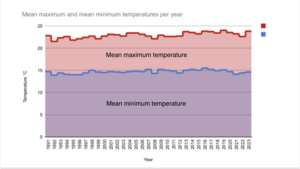14 year-old Anastasia Kulikova on the detrimental and highly influential effects of climate change in New South Wales, Australia

January 20, 2022. According to the WWF Australia, 60,000 koalas were impacted by the unprecedented 2019-2020 bushfires, which scientists directly link to global warming and habitat loss.
April 18, 2024
The impact of climate change in Australia
In Australia, every decade since 1950 has been warmer. Government records show that the mean temperature per decade has increased by an average of 1.44°C after national records began in 1910. Oceans around Australia have also warmed, by roughly 1°C, with more rapid warming in oceans to the south-east.
The weather mostly changed to be unpredictable.
Zobair Bary, who’s lived around Sydney for almost 30 years, told Harbingers’ Magazine that the regularity of the seasons has changed. Some summers have been relatively cold with temperatures dropping well below average. It also used to be very cold in August (the winter time in Australia) but is now warming up, sometimes even reaching 25°C in the afternoons.
“So the climate became a lot more moderate compared to what it used to be for an Australian climate: summers very hot and dry with at least one week 35–40°C, wet seasons – really wet. So it all was expected. Now it’s all over the place,” said Mr Bary.
Climate change has impacted all areas of life in New South Wales (NSW) – the most populous state in Australia, with over 8.3mn inhabitants. Highlighted below are some prominent examples.
Fires
One of the biggest burdens of climate change in NSW are bushfires. Unfortunately, fire danger is increasing – in 2019/2020 there were big fires that burned for months. It caused air pollution, which led to many health problems for people, exacerbating issues for those with respiratory problems.
The worst impact was on wildlife. Entire regions were burned, of up to 19mn hectares. Almost 3bn animals and birds, who could not run or fly away, suffered from burns. Some areas in NSW have specific bird species that only live in that area. Now, many of them have become endangered. Many seasonal insects, who reproduce in a certain environment, are in danger because of sudden weather changes.
Drought is also a threat to animals. In June 2018, 99% of NSW was proclaimed as affected by drought. The NSW Government website has projections about droughts becoming more severe and lasting longer.
Cost of food
When it gets too hot during the wet season, conditions can lead to hail storms that destroy crops. In recent years, extreme hail events in farming areas completely destroyed plantations, especially soft tropical fruits.
In 2022, New South Wales experienced its wettest summer in 30 years, leading to crop damage and rotting. For consumers, the extreme weather resulted in supply shortages, leading to higher food prices. The difficult impacts of extreme weather on farmland has had detrimental effects on farmers’ mental health, with some even committing suicide.
Architecture
People are slowly starting to change the architecture of their houses. Most people’s roofs in Australia are made up of clay tiles, which are good for dry and hot climates – but, when you experience constant rain, followed by sudden heat, then sudden cold, tiles crack and break. This leads to damage to houses and leaks. As temperatures get colder, people will have to install double glazing or spend much more money on heating, both of which are adding to expenses in a cost of living crisis.
Health
Constant rain has meant that rare diseases, including parasitic diseases, such as tick virus, malaria, dengue fever and Ross River virus are becoming more prevalent. In rural areas, where people rely on wells, they can get contaminated water. Also, sudden heat or cold is bad for elderly people because they are at higher risk of strokes or heart attacks.
Oceans
Oceans perform a vital role by acting as carbon sinks (by absorbing carbon dioxide and heat that comes from greenhouse emissions), but global warming changes ocean chemistry in a way that prohibits them from doing this. Rising water temperatures bleach coral reefs, this means they become white and die soon after.
Because of ocean warming, fewer tropical cyclones are expected, but they are likely to be more intense. Severe cyclones destroy reef structures and also damage kelp beds, which are not only a food source for marine wildlife but also produce oxygen and absorb carbon dioxide. Rising sea levels smother corals by promoting the growth of harmful algae and restricting them from adequate sunlight.





